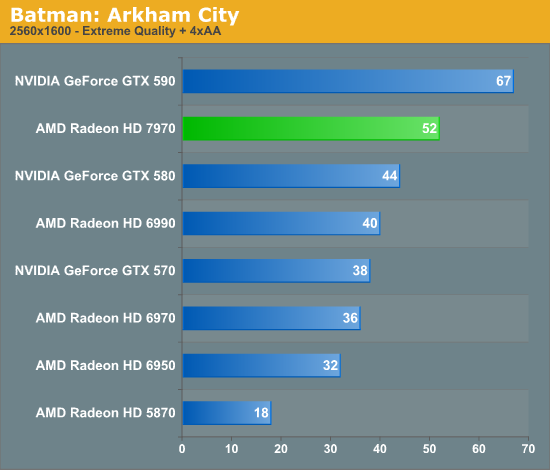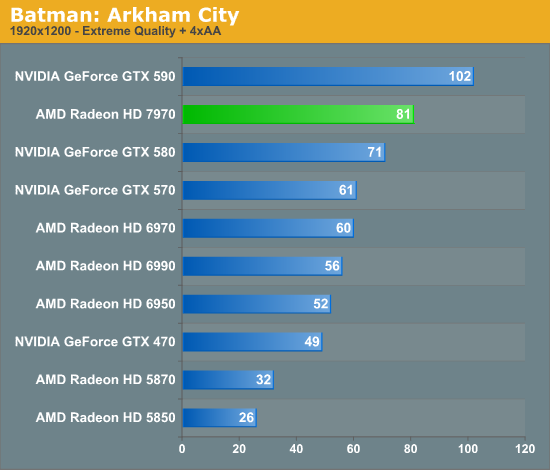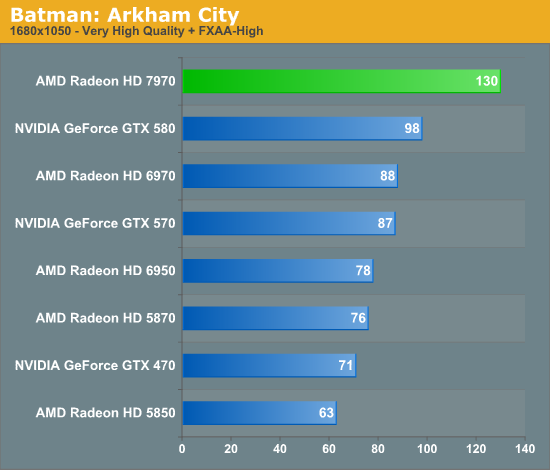AMD Radeon HD 7970 Review: 28nm And Graphics Core Next, Together As One
by Ryan Smith on December 22, 2011 12:00 AM EST- Posted in
- GPUs
- AMD
- Radeon
- ATI
- Radeon HD 7000
Batman: Arkham City
After a rocky launch last month, Rocksteady finally got their DirectX 11 problems sorted out for Batman: Arkham City earlier this month. Batman: Arkham City is loosely based on Unreal Engine 3, while the DirectX 11 functionality was apparently developed in-house. With the addition of these features Batman is far more a GPU demanding game than its predecessor was, particularly with tessellation cranked up to high.



At Extreme settings Batman is quite daunting for our entire GPU lineup at 2560. Nothing except the GTX 590 can crack 60fps, though the 7970 begins to come close at 52fps. Relative to NVIDIA’s lineup Batman ends up being one of the weaker games for the 7970, with the 7970 only taking an 18% lead over the GTX 580 at 2560. As for the 6970, the 7970 has another very strong showing opposite AMD’s previous generation, beating the 6970 by 44%.
At 1920 we’re still using Extreme settings and the story is much the same, though the 7970’s lead drops a bit more. Against the GTX 580 it’s now only 14% faster, and against the 6970 it’s 35% faster. Things do eventually pick up at 1680 when we back off to Very High settings and stop using MSAA, at which point the 7970 takes a surprising 32% lead over the GTX 580 while the lead over the 6970 jumps back up to 47%.
Looking at all of our cards it’s really the 5870 that tells the whole story. Tessellation plays a large factor in Batman’s performance, and as a result the partially tessellation-constrained 5870 absolutely struggles even at 1920. Consequently this is further proof that AMD was able to get a great deal of additional performance out of their geometry engines even with the 2 tringle/clock limit.










292 Comments
View All Comments
GTVic - Thursday, December 22, 2011 - link
The first Fermi version they demo'd was a mock-up held together with wood screws. That is not a good launch...RussianSensation - Thursday, December 22, 2011 - link
And the real launch version produced Tessellation performance that took HD7970 to pass, had compute performance that HD7970 can barely best today, had Mega Texture support that HD7970 just added now 2 years later, had scalar SIMD architecture that took AMD 2 years to release.Scali - Friday, December 23, 2011 - link
HD7970 doesn't actually surpass Fermi's tessellation, apart from tessellation factors 10 and below:http://www.pcgameshardware.de/aid,860536/Test-Rade...
From factor 11 to 64, Fermi still reigns supreme.
(This is with AMD's SubD11 sample from the DirectX 11 SDK).
Scali - Friday, December 23, 2011 - link
Uhhh no. They demo'ed a real Fermi obviously.It was just a development board, which didn't exactly look pretty, and was not in any way representative of the card that would be available to end-users.
So they made a mock-up to show what a retail Fermi WOULD look like, once it hits the stores.
Which is common practice anyway in the industry.
fllib19554 - Thursday, January 12, 2012 - link
off yourself cretin.futurepastnow - Thursday, December 22, 2011 - link
You misspelled "impressive."slayernine - Thursday, December 22, 2011 - link
What Wreckage really meant to say was that it was disappointing for nVidia to get pummelled so thoroughly.unaligned - Friday, December 23, 2011 - link
A year old card pummeled by the newest technology? I would hope so.MagickMan - Thursday, December 22, 2011 - link
Go shoot yourself in the face, troll.rs2 - Thursday, December 22, 2011 - link
Yes, yes. 4+ billion transistors on a single chip is not impressive at all. Why, it's not even one transistor for every person on the planet yet.